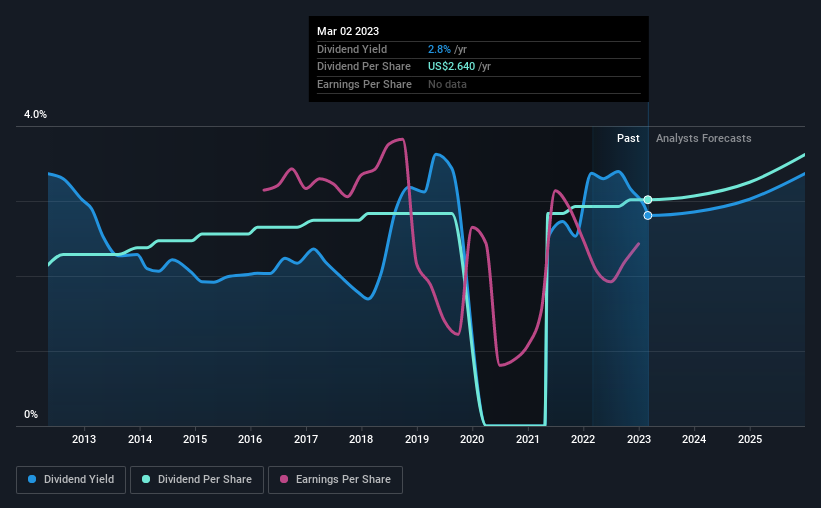Some investors rely on dividends for growing their wealth, and if you’re one of those dividend sleuths, you might be intrigued to know that Autoliv, Inc. (NYSE:ALV) is about to go ex-dividend in just 4 days. The ex-dividend date is one business day before a company’s record date, which is the date on which the company determines which shareholders are entitled to receive a dividend. It is important to be aware of the ex-dividend date because any trade on the stock needs to have been settled on or before the record date. Therefore, if you purchase Autoliv’s shares on or after the 7th of March, you won’t be eligible to receive the dividend, when it is paid on the 23rd of March.
The company’s next dividend payment will be US$0.66 per share, on the back of last year when the company paid a total of US$2.64 to shareholders. Looking at the last 12 months of distributions, Autoliv has a trailing yield of approximately 2.8% on its current stock price of $94.05. Dividends are a major contributor to investment returns for long term holders, but only if the dividend continues to be paid. That’s why we should always check whether the dividend payments appear sustainable, and if the company is growing.
See our latest analysis for Autoliv
If a company pays out more in dividends than it earned, then the dividend might become unsustainable – hardly an ideal situation. Autoliv is paying out an acceptable 53% of its profit, a common payout level among most companies. That said, even highly profitable companies sometimes might not generate enough cash to pay the dividend, which is why we should always check if the dividend is covered by cash flow. Autoliv paid out more free cash flow than it generated – 175%, to be precise – last year, which we think is concerningly high. It’s hard to consistently pay out more cash than you generate without either borrowing or using company cash, so we’d wonder how the company justifies this payout level.
While Autoliv’s dividends were covered by the company’s reported profits, cash is somewhat more important, so it’s not great to see that the company didn’t generate enough cash to pay its dividend. Cash is king, as they say, and were Autoliv to repeatedly pay dividends that aren’t well covered by cashflow, we would consider this a warning sign.
Click here to see the company’s payout ratio, plus analyst estimates of its future dividends.
Have Earnings And Dividends Been Growing?
Companies with falling earnings are riskier for dividend shareholders. If earnings decline and the company is forced to cut its dividend, investors could watch the value of their investment go up in smoke. Readers will understand then, why we’re concerned to see Autoliv’s earnings per share have dropped 6.0% a year over the past five years. Ultimately, when earnings per share decline, the size of the pie from which dividends can be paid, shrinks.
Another key way to measure a company’s dividend prospects is by measuring its historical rate of dividend growth. In the past 10 years, Autoliv has increased its dividend at approximately 3.5% a year on average. Growing the dividend payout ratio while earnings are declining can deliver nice returns for a while, but it’s always worth checking for when the company can’t increase the payout ratio any more – because then the music stops.
The Bottom Line
From a dividend perspective, should investors buy or avoid Autoliv? Autoliv had an average payout ratio, but its free cash flow was lower and earnings per share have been declining. With the way things are shaping up from a dividend perspective, we’d be inclined to steer clear of Autoliv.
With that in mind though, if the poor dividend characteristics of Autoliv don’t faze you, it’s worth being mindful of the risks involved with this business. Every company has risks, and we’ve spotted 2 warning signs for Autoliv you should know about.
Generally, we wouldn’t recommend just buying the first dividend stock you see. Here’s a curated list of interesting stocks that are strong dividend payers.
Have feedback on this article? Concerned about the content? Get in touch with us directly. Alternatively, email editorial-team (at) simplywallst.com.
This article by Simply Wall St is general in nature. We provide commentary based on historical data and analyst forecasts only using an unbiased methodology and our articles are not intended to be financial advice. It does not constitute a recommendation to buy or sell any stock, and does not take account of your objectives, or your financial situation. We aim to bring you long-term focused analysis driven by fundamental data. Note that our analysis may not factor in the latest price-sensitive company announcements or qualitative material. Simply Wall St has no position in any stocks mentioned.
Join A Paid User Research Session
You’ll receive a US$30 Amazon Gift card for 1 hour of your time while helping us build better investing tools for the individual investors like yourself. Sign up here
